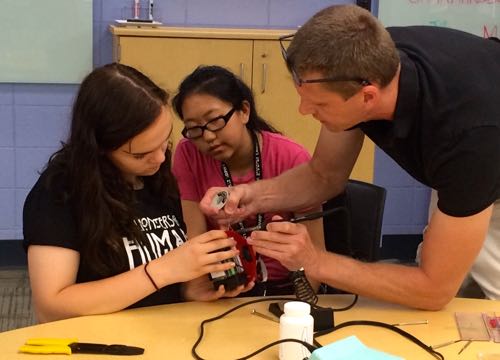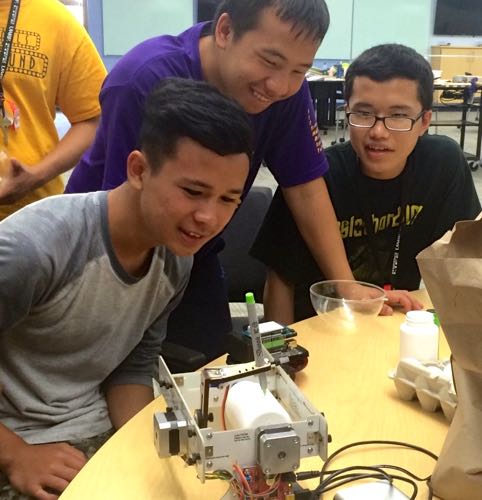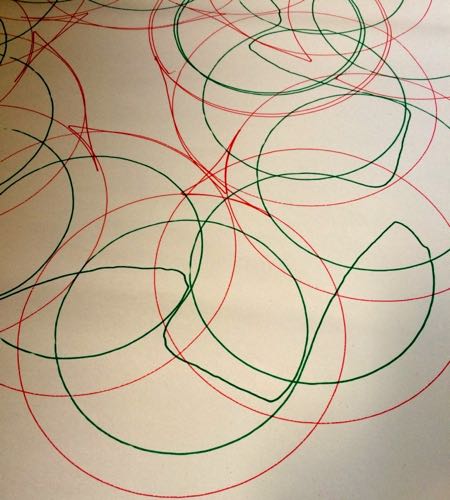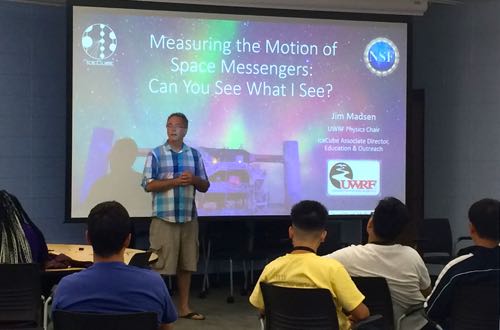These past two weeks, I had the privilege of teaching 25 wonderful Upward Bound students on the University of Wisconsin – River Falls campus. Our theme? Interactions.
Interactions of robots with their surroundings, interactions of robots with other robots, and interactions of particles as they hit the IceCube detector at the South Pole.
Robot Construction
Let’s start with the robots. First thing’s first, you have to build the robot. Put the gears in a certain order, solder wires to connect to the motors, combine the circuits boards, and voila, you have a robot.
 Mr. Thuma helps two students assemble the gear box.
Mr. Thuma helps two students assemble the gear box.
Easy right? Let me tell you, these high school students (yes, high schoolers!) put together their robot in just the first morning. Quite impressive to say the least. That’s when I knew we were in for a fun two weeks.
Of course, you can’t have a robot without a name. Mr. Muhs (pronounced “moose”), another Upward Bound teacher, brought along his Egg Bot. That’s right, a robot whose entire job is to write on eggs…or other egg-shaped objects.
 Students watch as Egg Bot traces out the name of their robot.
Students watch as Egg Bot traces out the name of their robot.
Each group had their robot’s name traced out on a white, empty pill bottle, later to be glued to the top of the robot’s dome to serve as a hat. Very stylish.
Meanwhile, we used the 3D printer (wow!) to fashion some nice clips to hold the dome on to the top of the robot. We may have also printed several pokemon along the way. Oops?
With the addition of LEDs to blink out the robot’s name in Morse code, our building (and decorating) stage was complete.
Robot Programming
With the robot built, we now had to tell it what to do. Students got experience with Arduino programming, very similar to C++ (for those non-programmers among us, C++ is a common programming language so it’s great the students are becoming familiar with it now!).
The goal? Make your robot go straight, turn right, and turn left.
If you’ve ever tried your hand at computer programming before, you know that the trouble-shooting programming errors can be one of the most frustrating and time-intensive tasks. If you forget one comma or one semicolon, nothing works the way it’s supposed to. I have to say I was very impressed by the amount of grit these students showed when it came to such a tedious task. They didn’t give up; they pushed through. They asked for help from other groups and used internet resources to guide them.
So, after sorting through several if-then statements, we had our robots up and “walking.”
At this point, we adding light sensors, or the technical term photoresistors. These little guys are the (very simple) eyes of the robot. The more light the sensor sees, the less resistance. The changing voltage across the photoresistor provides an input to the Arduino that allows the robot to respond to varying light levels. By closely monitoring the photoresistor’s numbers and some crafty coding, we were eventually able to get the robot to go towards light and stop at the brightest spot.
There you have it, a robot interacting with it’s environment. Just like a moth goes to a light when it's dark outside, our robots were responding to light.
Robot Talent Show
At this point, we teachers wanted to loosen the reigns and see what these students could accomplish. We called the final project Creative Bot - students were to make their robot do “something cool.” And that they did!
Some groups attached markers to their robots, programming it to draw out shapes to create a piece of artwork.
 Artwork drawn by a robot that students programmed. The group titled this piece "Petals of Heaven."
Artwork drawn by a robot that students programmed. The group titled this piece "Petals of Heaven."
Others attached touch sensors to help their robots “feel” when they hit an object. A few groups put a speaker on top of their robot to play twinkle-twinkle-little-star. Perhaps my favorite was the slow-motion Pokemon battle that ensued (if you haven’t noticed, Pokemon are quite popular right now).
Our robot talent show was quite an impressive sight to see. And best of all, these robots were interacting through light, touch and sound with their surroundings.
Connection to IceCube
Despite what you may think, our class at Upward Bound was not called “Robotics” – it was titled IceCube. So why did we spend so much time on robots, you might ask? Let’s return to our theme: Interactions.
We programmed our robots to interact with the world around them. If the right light sensor detects light, then it turns right; if the left light sensor detects light, then it turns left.
The IceCube detector is also looking for interactions – interactions that occur when tiny particles from outer space hit the ice at the South Pole. We call those tiny particles neutrinos and they may just hold some of the secrets of the cosmos.
Dr. Madsen, the Associate Director for Education & Outreach on IceCube, came to speak to the students about what it takes to be a scientist researching at the South Pole. His main message: You can do it too!
 Dr. Madsen talks to the students about project IceCube.
Dr. Madsen talks to the students about project IceCube.
The thing is, everyone starts not knowing much about a topic. But with time and effort, you learn more and more about it. Eventually you’ve learned so much that others start calling you an expert and you get funding to take you places like the South Pole.
Okay, confession time. Before Upward Bound, I had never built a robot before. Even a small one. Never. I came in knowing very little and feeling pretty self-conscious about my lack of knowledge in this area. But, after two weeks of trying, failing, and trying again, I am much more confident in my robot construction and programming skills. I, and those 25 Upward Bound students, am proof that you really can achieve what you put your mind to.
Until Next Year
I had such a blast at Upward Bound this year. The teachers were top-notch, the students were fabulous, and our robots turned out awesome!
I'll leave you with one final video of the 25 students spelling out "Upward Bound!"...filmed from a drone, of course!


Comments